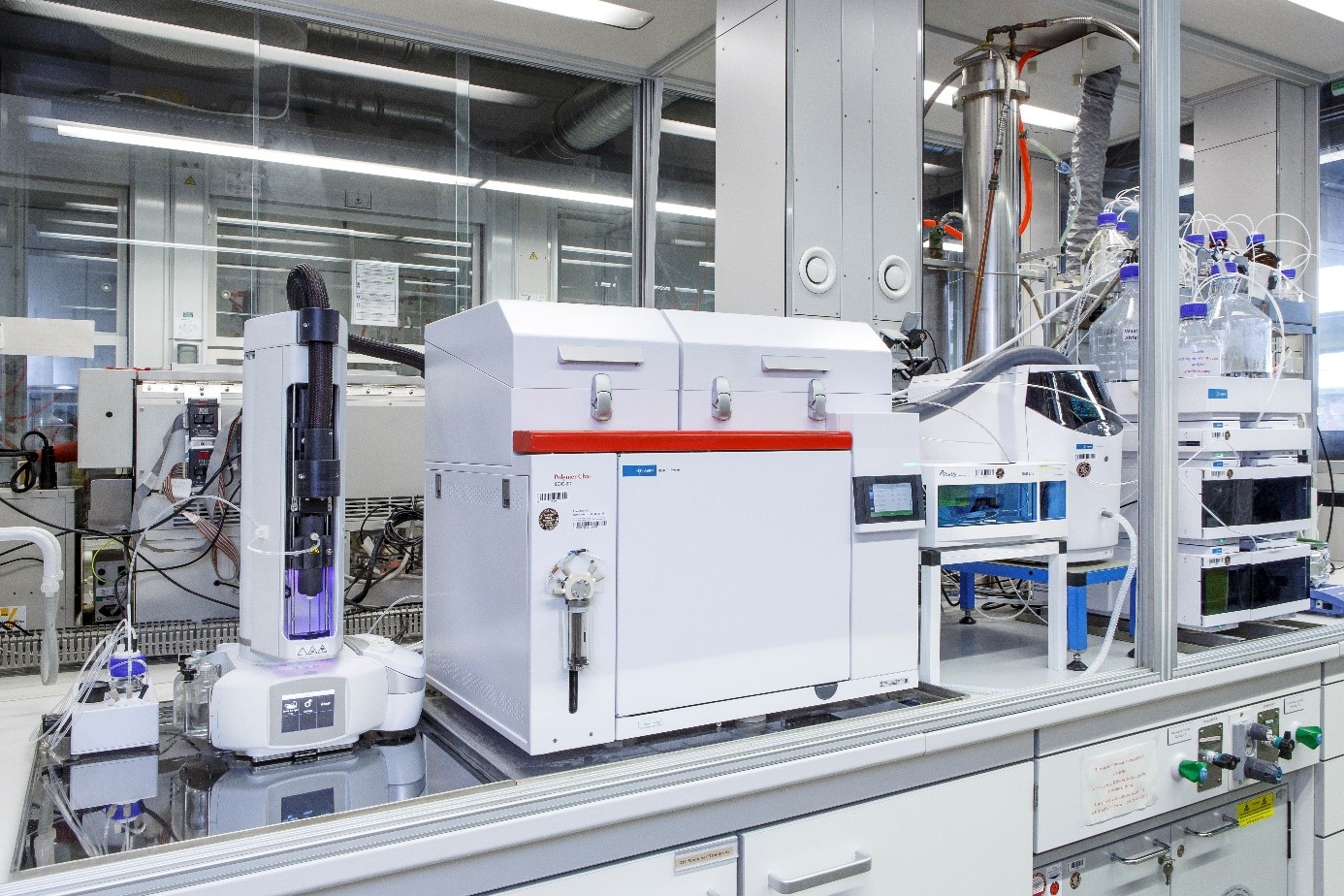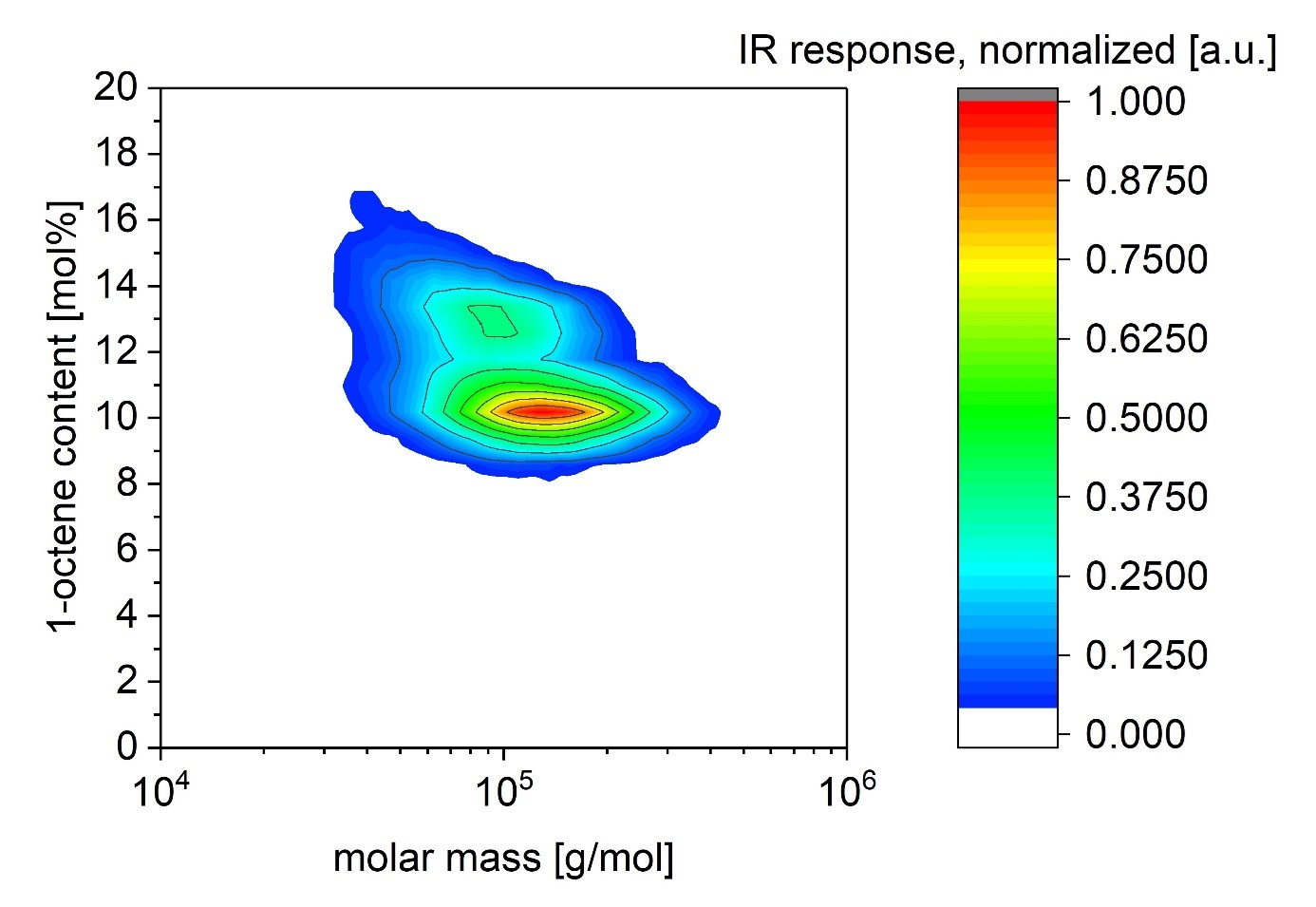Gel permeation chromatography (GPC) and high performance liquid chromatography (HPLC) provide valuable information about the molar mass distribution of polymers on the one hand and about their chemical composition on the other hand. The informative value of both methods does have limits, however, when more complex mixtures are regarded. A good example is impact-modified polypropylene. This is, basically, a mixture of a high amount of polypropylene homopolymer and a lesser amount of ethylene propylene copolymer. A GPC characterization of such a material gives the molar mass distribution of the mixture and (with short-chain branching detection) a first indication of the relation of the molar mass distributions of the components. An HPLC characterization, on the other hand, gives information about the distribution of the chemical composition. It does, however, not differentiate by molar mass. Thus, components of similar chemical composition but different molar mass distribution will be initially classified as one component. The individual weaknesses of both methods can be compensated by hyphenating them. This hyphenation has been termed two-dimensional liquid chromatography (2D-LC).
Two-dimensional liquid chromatography (2D-LC)

Working principal
Often, the sample is initially separated by HPLC. The solvent eluting from HPLC is collected in small fractions (typically 100 µL) and each fraction is immediately separated by GPC (HPLC x GPC). Thus information on the chemical composition and the associated information on the molar mass distribution can be obtained. For the aforemention example, it can be determined what the molar mass distribution of the homopolymer and the copolymer (or even just parts of these components) looks like individually. On the other hand, components with a similar chemical composition but different molar mass distribution (for example ethylene copolymers originating from different catalytical centers) can be identified. The hyphenation variant HPLC x GPC is used for automated hyphenation setups (online hyphenation) as GPC separations can be performed faster compared to HPLC separations (which can be deliberately slowed down more easily in turn). For certain applications it can be more favorable, however, to perform a GPC x HPLC hyphenation. In such cases, multiple GPC fractions are collected, stored and finally analyzed by HPLC (offline hyphenation). The offline approach is also feasible when an automated setup is not available.
Presentation of results
The results of a 2D-LC analysis are usually portrayed in a contour plot. Conventionally, the molar mass is portrayed on the x-axis and the composition (HPLC elution volume) is portrayed on the y-axis. The concentration information is conveyed through different colors. Three-dimensional depictions are also possible. Moreover, approaches have been developed to work with the data in a matrix format and to perform matrix calculations for a more objective comparison of different samples.
Fields of application
- Material comparison (good vs. faulty batch)
- Elucidation of complex compositions and differentiated characterization of the components (e.g., impact-modified polypropylene, recyclates)
- Determination of detailed structural data as the basis for structure property relationships
- Investigation of correlations between post-reactor modifications and molar mass
- Elucidation of correlations between composition/tacticity and molar mass of (co)polymers

Publications:
- J. H. Arndt, S.S. Bhati, M. Ellwanger Cangussu, G. Geertz, H. Mohammadi, R. Brüll, Unraveling the comonomer distribution in ethylene – vinyl ester terpolymers through liquid chromatography with infrared detection, J. Chrom. A 1705 (2023) 464197, DOI: 10.1016/j.chroma.2023.464197
- J. H. Arndt, R. Brüll, T. Macko, P. Garg, J. C. J. F. Tacx, In-depth characterization of polyolefin plastomers/elastomers (ethylene/1-octene copolymers) through hyphenated chromatographic techniques, J. Chrom. A 1621 (2020) 461081, DOI: 10.1016/j.chroma.2020.461081
- K. Rode, F. Malz, J. H. Arndt, T. Macko, G. Horchler, Y. Yu, R. Brüll, Studying the bivariate tacticity distribution of poly-1-octene using two-dimensional liquid chromatography coupled with NMR, Polymer 174 (2019) pp. 77-85, DOI: 10.1016/j.polymer.2019.04.036
- N. Apel, V. Ramakrishnan, E. Uliyanchenko, S. Moyses, C. Wold, T. Macko, R. Brüll, Correlation between Comprehensive 2D Liquid Chromatography and Monte Carlo Simulations for Branched Polymers, Macromolecules 51 (2018) pp. 4829- 4839, DOI: 10.1021/acs.macromol.8b00667
- N. Apel, E. Uliyanchenko, S. Moyses, S. Rommens, C. Wold, T. Macko, R. Brüll, Separation of Branched Poly(bisphenol A carbonate) Structures by Solvent Gradient at Near-Critical Conditions and Two-Dimensional Liquid Chromatography, Anal. Chem. 90 (2018) pp. 5422-5429, DOI: 10.1021/acs.analchem.8b00618
- S. S. Bhati, T. Macko, R. Brüll, Quantification of identical and unique segments in ethylene-propylene copolymers using two dimensional liquid chromatography with infra-red detection, Polyolefins Journal 3 (2016) pp. 119-133, DOI: 10.22063/poj.2016.1323
- A. Ginzburg, T. Macko, V. Dolle, R. Brüll, Characterization of polyolefins by comprehensive high-temperature two-dimensional liquid chromatography (HT 2D-LC), European Polymer Journal 47 (2011) pp. 319 – 329, DOI: 10.1016/j.eurpolymj.2010.11.016
 Fraunhofer Institute for Structural Durability and System Reliability LBF
Fraunhofer Institute for Structural Durability and System Reliability LBF